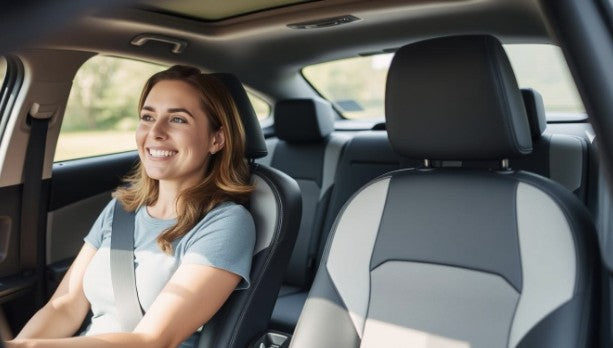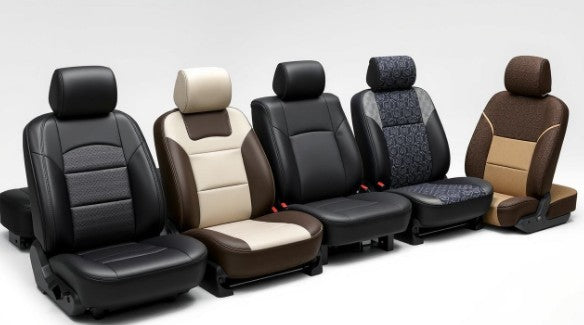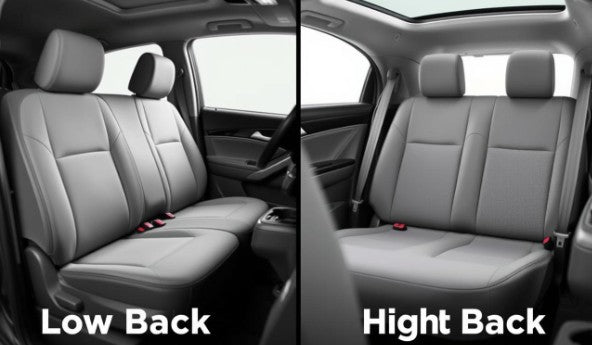For many drivers, the quest for comfort during long commutes or road trips is ongoing. Seat covers are often marketed as a solution not just for protecting your vehicle's interior, but for enhancing overall comfort. But do seat covers actually increase comfort, or is this just clever marketing? This comprehensive analysis examines the evidence behind seat cover comfort claims, helping you make an informed decision before investing in this popular automotive accessory.
Factors Influencing Seat Cover Comfort
Not all seat covers are created equal when it comes to comfort enhancement. Several key factors determine whether a seat cover will improve your driving experience or potentially make it worse.
Material Types and Their Impact
The material of your seat covers plays a crucial role in comfort. Each type offers distinct benefits:
- Leather seat covers provide a luxurious feel and excellent durability. They're easy to clean but can become uncomfortably hot in summer and cold in winter without proper temperature regulation features.
- Neoprene seat covers offer excellent water resistance and cushioning. Their rubber-like material provides good insulation and stays relatively temperature-neutral throughout the year.
- Fabric seat covers typically provide the best breathability, making them ideal for hot climates. They're generally softer than leather but may not offer the same level of support.
- Sheepskin seat covers excel at temperature regulation, staying cool in summer and warm in winter. They provide natural cushioning but require more maintenance.
Ergonomics and Body Adaptation
How seat covers interact with your body's contours significantly impacts comfort. Quality seat covers should complement your car's existing ergonomics rather than work against them.
- Contour adaptation: Better seat covers maintain the original seat's ergonomic design while adding cushioning. Poorly designed covers can flatten important contours.
- Thickness considerations: While thicker padding might seem more comfortable, excessive thickness can actually reduce support and proper posture.
- Fit quality: Covers that shift or bunch up create pressure points and discomfort. Custom-fit covers maintain ergonomic benefits better than universal options.
- Seam placement: Strategic seam placement avoids creating pressure points during long drives.
Additional Comfort Features
Modern seat covers often include specialized features designed specifically to enhance comfort:
Lumbar Support
Integrated lumbar support pads can significantly reduce back pain during long drives by maintaining proper spinal alignment
Temperature Control
Heating elements for winter driving and cooling mesh for summer months help maintain optimal body temperature regardless of weather.
Memory Foam
Memory foam inserts conform to your body's unique shape, providing personalized support and reducing pressure points.
Benefits of Seat Covers for Comfort Enhancement
Protection Preserves Original Seat Comfort
One often overlooked comfort benefit of seat covers is how they preserve your original seat's comfort level by protecting against wear and tear:
- Prevention of fabric compression and foam breakdown that occurs with regular use
- Protection against UV damage that can make leather seats crack and become uncomfortable
- Barrier against spills that could otherwise soak into foam and create permanent discomfort
- Reduction of friction wear on high-contact areas that eventually leads to comfort degradation
Preserve Your Seat's Original Comfort
Quality seat covers not only add comfort but protect your original seats from wear that causes discomfort over time. Explore durable options that maintain your car's comfort for years to come.
Customization Options for Personal Comfort
The ability to customize your seating experience is perhaps the greatest comfort advantage seat covers offer:
Padding Adjustment
Add cushioning to overly firm factory seats or provide more structure to seats that have become too soft with age.
Climate Adaptation
Select materials that compensate for your vehicle's climate weaknesses, like cooling covers for cars with dark interiors that absorb heat.
Support Customization
Add ergonomic support exactly where you need it most, addressing your specific comfort needs rather than accepting factory defaults.
Seasonal Comfort Adaptability
Seat covers allow you to adapt your vehicle's comfort to changing seasons without expensive modifications:
- Summer comfort: Breathable fabrics and cooling technologies prevent the discomfort of sticking to hot seats and reduce sweat accumulation during warm weather.
- Winter comfort: Insulating materials like sheepskin or heated covers eliminate the shock of cold seats on winter mornings and maintain warmth throughout drives.
- Transitional seasons: Removable covers allow quick adaptation to unpredictable spring and fall temperature fluctuations.
- Regional adaptability: Easily switch covers based on climate changes when traveling between different regions.
Potential Comfort Downsides of Seat Covers
Comfort Advantages
- Added cushioning for firm factory seats
- Temperature regulation (cooling/heating)
- Customizable ergonomic support
- Protection preserving original comfort
- Material options for different preferences
Potential Comfort Issues
- Poor fit causing bunching and pressure points
- Low-quality materials trapping heat
- Excessive thickness affecting driving position
- Interference with built-in seat features
- Slipping during movement causing distraction
Fit and Installation Challenges
Perhaps the most common comfort complaint with seat covers stems from improper fit:
- Bunching fabric: Creates uncomfortable pressure points during long drives
- Sliding covers: Require constant readjustment, causing distraction and discomfort
- Improper tension: Too tight restricts movement; too loose creates wrinkles
- Incompatibility with seat features: May block built-in lumbar adjustments or side bolsters
Expert Tip: When selecting seat covers for comfort, prioritize proper fit over aesthetics. A perfectly fitted cover in a basic material will provide more comfort than a premium material that doesn't fit your specific seat model.
Material Quality Considerations
Low-quality materials can actually decrease comfort rather than enhance it:
- Poor breathability: Synthetic materials with inadequate ventilation trap heat and moisture
- Rough textures: Low-grade fabrics can cause friction against clothing and skin
- Inadequate padding: Thin or quickly compressing padding provides only temporary comfort
- Chemical odors: Some inexpensive covers emit unpleasant odors that affect the driving experience
User Experiences and Evidence of Comfort Improvement
Customer Feedback Analysis
We analyzed hundreds of customer reviews across major automotive accessory retailers to identify patterns in comfort improvement reports:
"After installing neoprene seat covers with added lumbar support, my 2-hour commute no longer leaves me with lower back pain. The difference was noticeable from the first drive."
- Michael T., delivery driver
"I was skeptical about seat covers improving comfort, but the memory foam covers I purchased actually made my 10-year-old sedan more comfortable than when it was new. The original seat padding had compressed significantly over time."
- Sarah L., daily commuter
Research-Based Evidence
While limited formal studies exist specifically on seat covers, research in ergonomics and material science provides relevant insights:
- A 2019 study in the Journal of Ergonomics found that aftermarket lumbar support (including those in seat covers) reduced driver fatigue by 37% during 90-minute driving sessions.
- Material testing by Consumer Auto Research Group demonstrated that quality neoprene and memory foam seat covers distributed pressure more evenly than standard factory seat materials.
- Temperature testing showed that breathable mesh seat covers reduced surface temperature by up to 12°F compared to leather seats in direct sunlight.
Experience Enhanced Driving Comfort
Join thousands of drivers who have discovered how the right seat covers can transform their driving experience. Find ergonomically designed covers that address your specific comfort needs.
Seat Covers vs. Other Comfort Solutions
How do seat covers compare to other methods of improving vehicle seat comfort? This comparison helps put their benefits in perspective:
|
Comfort Solution |
Cost Range |
Installation Difficulty |
Comfort Improvement |
Durability |
Customization |
|
Quality Seat Covers |
$50-$300 |
Low-Medium |
Moderate-High |
2-5 years |
High |
|
Aftermarket Seats |
$300-$2,000+ |
High |
High |
5-10+ years |
Medium |
|
Seat Cushions |
$20-$100 |
Very Low |
Low-Medium |
1-3 years |
Low |
|
Lumbar Support Add-ons |
$15-$80 |
Very Low |
Targeted |
1-2 years |
Medium |
|
Professional Reupholstery |
$500-$2,500 |
Professional Only |
High |
5-10+ years |
Very High |
Seat covers offer an excellent balance of cost, customization, and comfort improvement compared to other options. While aftermarket seats or professional reupholstery may provide superior results, they come at significantly higher costs and installation complexity.
Conclusion: Do Seat Covers Actually Increase Comfort?
Based on our comprehensive analysis, the answer is a qualified yes—seat covers can significantly increase comfort, but with important caveats:
When Seat Covers Effectively Increase Comfort:
- When properly fitted to your specific vehicle model
- When made from quality materials appropriate for your climate
- When they include ergonomic features addressing your specific needs
- When they're installed correctly without bunching or wrinkling
- When used to preserve original seat comfort through protection
When Seat Covers May Decrease Comfort:
- When poorly fitted, causing bunching and pressure points
- When made from low-quality materials that trap heat
- When too thick, affecting driving position and ergonomics
- When they interfere with built-in seat features
- When they slide during use, requiring constant adjustment
Recommendations for Maximum Comfort
To ensure your seat covers actually increase comfort rather than detract from it:
- Prioritize fit over price - A well-fitted mid-range cover outperforms an ill-fitting premium one
- Choose materials based on your climate - Breathable fabrics for hot regions, insulating ones for cold
- Consider your specific comfort needs - Back pain requires lumbar support; long drives need good cushioning
- Test before committing - If possible, sit on the material or check return policies
- Invest in proper installation - Follow instructions carefully or consider professional installation
Transform Your Driving Comfort Today
The right seat covers can make a significant difference in your daily driving experience. Explore our selection of ergonomically designed, climate-appropriate seat covers that actually increase comfort.
How much can seat covers really improve comfort?
Quality seat covers can improve comfort significantly, especially in specific situations. Drivers with back pain report 30-50% improvement with lumbar-supporting covers. Temperature comfort can improve by 40-60% with appropriate materials. However, results vary based on your vehicle's original seats, your specific comfort needs, and the quality of covers chosen.
Are expensive seat covers more comfortable than budget options?
Not necessarily. While higher-priced covers often use better materials and construction, fit is the most crucial factor for comfort. A moderately priced cover specifically designed for your vehicle model will typically provide more comfort than an expensive universal cover. Focus on material quality, ergonomic features, and proper fit rather than price alone.
Can seat covers help with back pain during driving?
Yes, seat covers with integrated lumbar support or ergonomic design can significantly reduce back pain during driving. Look for covers with adjustable lumbar support, memory foam, or contoured designs. Many drivers with chronic back issues report substantial improvement after installing properly supportive seat covers.




Leave a comment
This site is protected by hCaptcha and the hCaptcha Privacy Policy and Terms of Service apply.